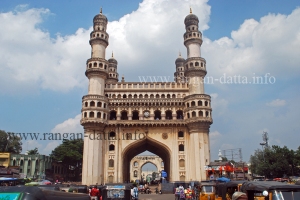Hyderabad and Warangal
Hyderabad and Warangal
FAM (Familiarization) tour of Andhra Pradesh Tourism Development Corporation (APTDC)
A thundering voice echoed through the ruins of an ancient fort depicting the the tales of a long lost kingdom and battles long ago. Relevant portions of the fort were lit up to add a new dimension to the story.
Probably you have got it by now, its the sound and light show at the Golconda Fort, Hyderabad and I was part of a 3 day (8 – 10 Oct. 2013) FAM (Familiarization) trip of Hyderabad and Warangal organized by the APTDC.
Day 1: Lumbini Park, Charminar, Taramati Baradari, Shilparamam and Golconda Fort
It all started less than 12 hours early with the visit to Lumbini Park, located on the shores of the gigantic Hussail Sagar Lake, at the very heart of Hyderabad. The 7.5 acres Lumbini Park was constructed in 1994 and attracts both locals and tourist.
The entrance is past a floral clock and the park provides various sorts of slides and merry go round for children.
But the prime attraction of the Lumbini Park is the boat ride to the island housing the giant statue of Buddha.
Said to be the largest monolithic statue of Buddha in India it towers to a height of of 17 meters and weighs 320 tonnes. The stone was transported from the Raigiri area about 60 km away, in a specially designed carriage with 192 wheels. It was curved out of a massive rock by 40 sculptors under the supervision of master craftsman Ganapati Satapathi.
The giant Buddha statue stands on a decorative pedestal flanked with twin lions on the four corners and contain intricate relief work depicting the various phases of the life of Buddha.
The next stop was Charminar, a monument that requires no introduction. Charminar literally means four towers and the monument consists of four ornate minars attached to the corners of a square structure supported by four giant arches.
Located at the intersection of the two historic trade routes that connected the markets of Golconda to the port of Masulipattanam. Today it is located in one of the most congested areas of Hyderabad.
Constructed in 1591 by Md. Quli Qutub Shah the Charminar once doubled up as a mosque and madrassa (Islamic religious school). Today it is a protected monument under Archeological Survey of India (ASI).
Visitors are allowed to the first floor of Charminar via a 50 step narrow spiral staircase. The balcony offers great views not only of the exteriors but also of the intricately designed interiors. The balcony also offers great view of the Mecca Masjid and the Golconda Fort nestled on top of hill in the outskirts of the city.
The Charminar was followed by lunch at Taramati Baradari. Baradari literally means twelve doors. Taramati Baradari is a open platform with twelve doors named after Taramati, the courtesan of Ibrahim Quli Qutab Shah, the second ruler of the Qutab Shahi dynasty.
The open platform stands on a hill overlooking the Musi River and the entire area is converted into a landscaped garden with a restaurant, open air auditorium and souvenir shops.
Next stop was the Golconda Fort located about 11 km west of Hyderabad. Golconda literally meaning the Shepperd’s Hill was original a mud fort built by the Kakatiyas of Warangal. The Qutab Shahi rulers of Hyderabad transform it into a stone citadel. Over several centuries it became a citadel of Qutab Shahi dynasty, Golconda Fort was finally abandoned after the invasion of Decan by Aurangzeb.
Golconda was also famous for its diamonds and at that time it was the only source of diamond in the entire world. Famous diamonds like the Kohinoor and the Hope are all found from the Golconda diamond fields.
Golconda boosts an amazing acoustic, sound of clapping hands at the entrance is said to be heard at interior of the fort several miles away. Visitors at the Golconda Fort still claps their hands expecting fellow visitors to hear it, deep inside the fort.
An entire day is required to explore the fort but our visit was restricted to only an hour allowing to explore only the outer reaches of the gigantic fort.
Shilparaman, the craft’s village, was the next stop. Located at the heart of the hi – tech city of Hyderabad 65 acre Shilparamam gives a scenic ambiance of art and cultural heritage.
The entire park is landscaped and contains several sections like the rural museum and rock gardens. Models are arranged to create a total village atmosphere. There are stalls selling handicrafts and artifacts. A beautifully decorated bullock cart makes it was round the park and dancers also performs. Ethnic festivals are also celebrated with dance and music shows.
Finally it was time to call it a day but not before a visit to the Golconda Fort again for a fascinating sound and light show, depicting the brief history of the fort and the Shah dynasty.
Day 2: Yadagirigutta Temple, Kolannupaka Jain Temple, Cherial (Cheriyal) Scroll Painting, Pembarti Brass Works, Warangal Fort and Bhadrakali Temple
Day 2 started with the visit to Yadagirigutta Temple. The temple dedicated to the Vishnu avatar Lord Narasimha., who serves as the guardian deity of the citizens of Hyderabad. The Yadagirigutta Located on a hill and is just 61 km north – east of Hyderabad.
Originally a cave temple on top of a hill, it has been crowned with a multi coloured towering sikhara, The sikhara on the other hand is crowned with a chakra, considered to possess mystic power and value. At night the illuminated chakra is visible from far and wide.
Lord Narashima at Yadagirigutta is a multi faced God and even sometimes assumes the role of a doctor. He is said to appear in the dreams of devotees suffering from chronic disease and suggest the name of medicine to them.
Next to the temple is a shed like structure providing shelter to the wooden chariot. There are several other temples and shrines scattered in the complex.
Next stop Kolannupaka, housing a Jain Temple. Andhra Pradesh is always known for its rich Buddhist heritage but the state hardly boosts any Jain heritage. Thus the Jain Temple in the midst of a Hindu and Buddhist stronghold appears totally out of the blue.
The temple said to be 2000 years old but the it has been renovated in the recent years by 150 artisans from Gujarat and Rajasthan. The temple with intricate sandstone sculptures and mosaic works has remarkable resemblance with the Dilwara Temple of Rajasthan.
Kolannupaka also house the ruins of the Someswara Temple. The 1000 year temple has not survived the test of time but the ASI has converted the temple complex into a open air museum, containing amazing sculptures. The site also contains a buried shiva lingam along with a Nandi Bull and a step well.
Cherial (Cheriyal), the village known for its colourfull scroll paintings was the next stop. Cherial scroll painting is said to originate in the 16th century and is a traditional form of Telengana painting.
Today only four families in Cherial (Cheriyal) village, about 100 km from Hyderabad, still practices this art. Organic paints are applied on a specially treated khadi cloth, to depict various scenes of legend and mythology. The paintings are also accompanied by background musics and songs along with wooden dolls given a complete package of audio – visual entertainment.
We continued with Pembarti, the village famous for metal and brass works. It was also the place we stopped for our lunch.
Finally we proceeded for the city of Warangal, our night halt., but not before visiting the famous Warangal Fort.
The citadel of the famous Kakatiya dynasty, the Warangal Fort was destroyed by the successive invasion of the Khiljis and Tughlags. Today the excavated ruins of the fort are converted into a giant open air museum.
The four cardinal directions of the Warangal Fort archaeological park is marked with four gigantic and beautiful gateways known as Hydri Darwaza. The archaeological park contains scattered statues of Ganesha, Shiva, Nandi Bull along with pillars and arched gateways with intricate floral and geometric motif.
The second day of the FAM trip of Warangal ended with a visit to the Warangal’s famous Bhadrakali Temple where the festival of Batkama was underway.
Day3: Ramappa Temple, Ghanpur Group of Temples, Laknavaram and Thousand Pillar Temple
On Day 3 we moved out of Warangal and headed for the village of Palampet for the Ramappa Temple. Early thirteen century temple was constructed by General Recherla Rudra, during the reign of the Kakatiya ruler Ganapati Deva. Ramappa Temple is probably the only temple in the world to be named named after its architect.
The main temple of Ramalingeswara standing on a elevated star shaped platform and is made of sandstone. The spire is built of very light bricks, which are said to float in water. The prime attraction of the temple are the basalt brackets supporting the extended roof. Each of these basalt brackets contains beautifully sculptured figures of female tribal dancers.
The main temple is flanked on both side by similar but smaller temples of Kameswara and Kateswara. The complex also contains several other structures including a Nandi Mandap contacting a giant decorated Nandi statue.
No visit to Ramappa Temple is complete without a visit to the man made Ramappa Lake.
Next stop is Laknavaram Lake, another huge man made lake dug about during the Kakatiya rule. A set of two huge suspension bridges leads to an island, housing a small but elegant resort of APTDC. Boating facilities are also available and its a place to laze over cups of coffee.
Next stop was the Ghanpur Group of Temples a spectacular collection of temples built by the Kakatiya dynasty. The Ghanpur Temple Complex contains 22 temples enclosed with a walled en closer.
Like the Ramappa Temple here also the central temple is built on a star shaped raised platform and contains intricate carvings on both inner and outer walls.
There are several other temples and other structured scattered in the complex. Although most of the structures are in ruins it creates a mesmerizing effect transporting one back in time and straight into the pages of history.
It was time to head back to Warangal but not before visiting the famed Thousand Pillar Temple, another marvel of the Kakatiya Dynasty.
It was festival time and Batkama festival was also being celebrated even in the ASI protected site of Thousand Pillar Temple.
The age old structure is covered with fancy lights and make shift structures block major portions of the Thousand Pillar Hall.
The temple built by the Kaktiyas has intricate stone works on both its inner and outer walls.
Finally it was time for home and a race against time allowing me to board my plane just before it took off.
Orientation:
The FAM tour of Hyderabad and Warangal organized by APTDC was based at Hyderabad (Hotel Haritha Plaza. Ph: 040 4949 5959, M: 0 95538 33319)and Warangal (Haritha Hotel Kaktiya Ph: 0870 2562236/37).
Also APTDC has a number of hotels en-route:
- Taramati Baradari, Hyderabad (Ph: 040 2003 o352, M: 0 98488 27102)
- Yadagiri Gutta (Ph: 08685 237217)
- Ramappa (Ph.: 0871 5200200, M: 0 99481 00450)
- Laknavaram (0 88970 65307)
Special Thanks:
- Kalyani, Consultant Sales and Marketing, APTDC
- Dr. P. Jogi Naidu, Dy. Director (Retd.), Archeology and Museums, AP
- Kiran Mehata and Sunil Vidayanatahn my fellow FAM tour participant
- Santosh our driver
- All the staff of APTDC
Leave a comment Cancel reply
Blogroll
Explore India
Blog Index:
- Kolkata (Calcutta)
- West Bengal (Excluding Kolkata)
- Andhra Pradesh and Telengana
- Bihar
- Delhi
- Jammu & Kashmir and Ladakh
- Jharkhand
- Karnataka
- Madhya Pradesh
- Maharashtra
- Orissa
- Sikkim
- Tamil Nadu
- Uttar Pradesh
- Uttarakhand
Popular Trending
Top Posts & Pages
- Adilabad Fort & Nai ka Kot, unknown forts next to Tughlaqabad Fort
- Maa Phire Elo, Durga Museum, Rabindra Sarobar
- Ancient Temples of Kalachuri Period, Amarkantak
- Taki, one day outing from Kolkata
- Temple of Dakshin Rai, Dhapdhapi
- Tughlaqabad Fort, the third city of Delhi
- Brihadeshwara Temple, Gangaikonda Cholapuram
- Halisahar and Kanchrapara, Temples and Pilgrimage
- Historical Sites of Purulia District
- Pancha Rathas, Mahabalipuram (Mamallapuram)
Recent Posts
- Food trail of Rajshahi region of Bangladesh
- Association of Buddhist Tour Operators (ABTO) Convention, Kushinagar
- Jim Thompson House, Bangkok – Intriguing tale of a silk tycoon
- Monsieur Raymond’s Tomb — Hyderabad’s French Connect
- Jaunpur, Uttar Pradesh – Fort, Mosques and more
- Shahi Qila, Jaunpur – A citadel on the banks of Gomti River
- Lal Khan’s Tomb, Varanasi – A forgotten tomb of a minister of Varanasi
- Rajghat, Varanasi – The oldest part of one of the world’s oldest cities
- Pune University – Heritage Tour
- Pune Zero Stone, a failed conservation and landscaping project
Archives
Categories
Blog Stats
- 2,011,803 people accidentally bumped into my blog




























Beautifully described Rangan.
Thanks Anuradha, your write ups on Hyderabad and Warangal came in great help.
Nice write up..thanks to Haritha group of hotels for hosting our team across all locations and Surekha Adimulam for her suggestion to visit someswaralayam & the support Tharuni team gave us during cheriyal and pembarthi visit
Thanks Kalyani
Haritha Group of Hotels really needs a mention for their excellent rooms, great food and warm hospitality.
NGO Tharuni and Surekha Adimulam also deserves a thanks.
Thanks once more for info.
superb write-up rangan da… koto ki j janchhi….
Thanks Supratim, I will be writing in details about some of the important places and topicslike Ramappa Temple, Ghanpur Group of Temples, Cheriyal Scroll Painting.
wow..rangan da…another great piece from the writer’s desk. very well written. and thanks to your write up i got to know about cheriyal scroll painting and later studied more on its tradition and art form.lovely write up!
Thanks Rajmota. I will be soon coming up with a detailed blog post on Cheriyal Scroll Painting.
Very good.
A suggestion: You should have posted each day as a separate post, for more exposure. 🙂
Thanks Mr T V Raj for your suggestion.
I have purposely kept the entire tour in a single post but I will be writing on many of the places or activities in greater details in separate blog post and cross linking then with these post.
Concise and compact. Awaiting for detailed writeups.
Thanks Amitabha
I am surprised that my previous comment vanished. I thought the ‘Comment’ will be published after Rangan goes through the same & ‘approves’. My impression is incorrect.
I shall be interested in the details of the temples as well as Cheriyal scrolls. Waiting for the series of blogs.
Dear Oranjautun (Shyamal Babu) your comment never appeared for moderation, must be some technical error.
I will definitely make seperate entries on Ramappa Temple, Ghanpur Group of Temples and Cherial Scroll Paintings. Starting from November they would be uploaded on the first Wednesday of every month.
Very well described Rangan. The next time you plan a trip do visit Ramoji film city Hyderabad its Certified by the Guinness World Records as the world’s largest film studio. The joy that flashes on knowing how our favorite movies were made is just wonderful feeling.
Thanks Lalit for your comments and suggestions. Frankly speaking I am not much of a film buff, so film cities are definitely are not in my must visit list.
But next time in Hyderabad I will keep you suggestion in mind, do keep in touch.
Hey Rangan, reading your blog and seeing the picture it looks like a well planned trip. Great piece of writing, I guess you should write a blog on how you plan these amazing trips.
Thanks Aarushi for the compliment, actually the trip was a FAM (familiarization) tour planned by Andhra Pradesh Tourism Development Corporation (APTDC), so the credit must go to them.
Thanks once more.
nice ramappa temple
Thanks Venkatesh, do have a look on my detailed blog post on Ramappa Temple
Your Article Is Very Nice, Each And Every pic is Very Beautiful.This Summer I will go The Warangal Fort And Near Temples.Thanks For Sharing The Information
Really a useful content
Thanks